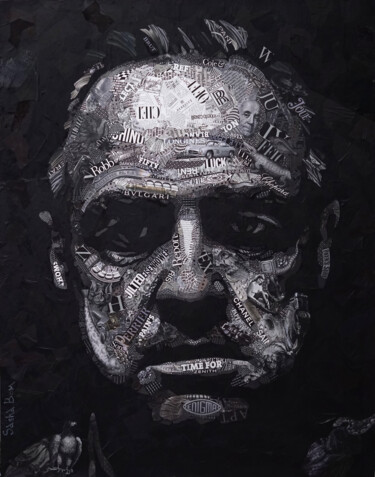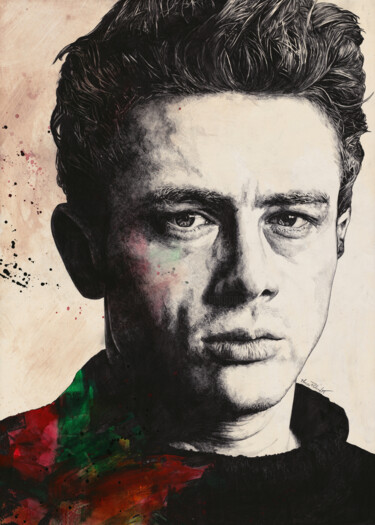 MIA WALLACE TOONS (2019) Painting by Noé Pauporté (Art de Noé).
MIA WALLACE TOONS (2019) Painting by Noé Pauporté (Art de Noé).
Many films remain with us, and I dare say that they even become embedded in our soul, so much so that we feel like some of their characters, or connect our life stories to their more intricate events, seeking, subsequently, the almost compulsive re-presentation of the sensations inherent in the special film in question, referring to a clear and sharp memory evoked, as well as "unlocked," by the world of images, mainly provided to us by the figurative multiplication of popular photography and posters. What happens instead when, rather than the involvement of the aforementioned "mechanical" arts, we talk about a painter who falls in love with a particular film, of which he "gives birth" to a personal version in oils, acrylics, etc., having the purpose of eviscerating his personal interpretation of a particular story or character? And again, what if we, instead of referring to the more static and faithful depiction of poster images, once again tell the story of the most well-known films, referring only to the more intimate tale revealed by the pictorial medium? Buying a work that speaks of a film is like coming into possession of a subject, or composition, that has been sounded out twice: first by the director, actors, set designers, etc., and second by the artist himself, who has given us the opportunity to make us aware of how only his eyes, and his mind, have seen the images flow, successively, one after the other. It is likely that it is in this very last vision that you will find your most personal and intimate interpretation of the film, that is, the one you have kept hidden in your heart, until you recognized it in pictorial art. Consequently, my top 10, in addition to linking, through the meaning of the films, the world of art to the world of cinema, also pursues the intention of providing you with revealing images, capable of making you gasp in thought: I, too, had felt that shot, that scene or that gesture, as depicted by the artist of Artmajeur.
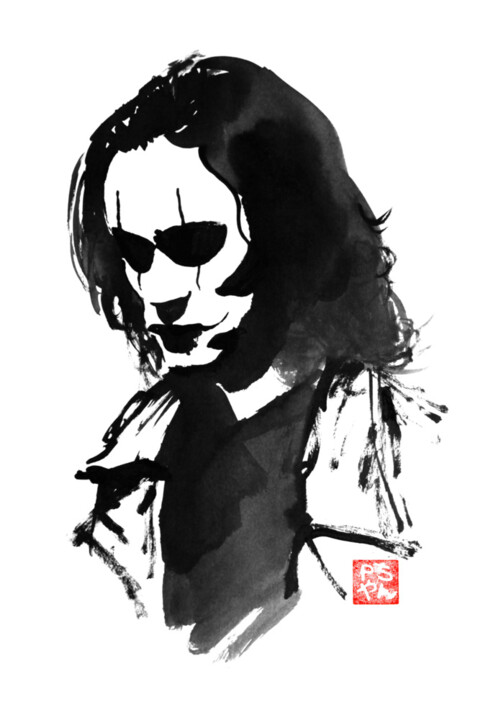 THE CROW (2016) Drawing by Péchane.
THE CROW (2016) Drawing by Péchane.
10. The Crow
The Crow, a 1994 film directed by Alex Proyas, is a well-known Gothic film, in that it presents a dark visual style, aimed to take shape in a decadent, crime-ridden city, in which the hero protagonist is presented as a tormented soul in search of revenge, repurposing a cinematic vision altogether capable of summing up in elements of horror, tragedy and romance. All these stylistic peculiarities can be found, in an extremely succinct and impactful way, in Péchane's Ink, in which the Crow's single, isolated and timeless presence summarizes, through his paranoid and thoughtful presence, all the existential drama inherent in the film's protagonist, culminating, however, in the most bitter real-life event, which, just like a poem of harsh irony, saw actor Brand Lee, fatally wounded during the shooting of the film in question, end his life on the film set. Now, instead, I propose a question: how to find a connection, even if somewhat forced, of Crow with the most other pictorial tradition? Easy! Just think of the film's mythical quote, "It can't rain forever," which, though of deeper meaning, makes me think how instead, in the most important works of art, aimed at immortalizing rain, it will flow forever, eternally wetting the faces, hands, hair and bodies of the protagonists of the medium, just as it does, for example, in Gustave Caillebotte's Street of Paris on a Rainy Day (1877).
 EDWARD SCISSORHANDS (2018) Painting by Julie Mallard.
EDWARD SCISSORHANDS (2018) Painting by Julie Mallard.
9. Edward Scissorhands
Before continuing with the narrative, I would like to clarify how the ranking in question was the result of a search for the works that are most significant to me, capable of summarizing the meaning of some of the most iconic films, without taking into account my personal taste in film, although I do not hide how the number one position represents, for all intents and purposes, one of the masterpieces of cinema to which I am most attached. After this first confession follows the second one: the chosen works also demonstrate a certain popularity, as well as recurrence, of certain films within contemporary art, as if for some films it was difficult for me to find iconographic sources, for others the game was extremely easy, just as if to demonstrate a certain affinity, found between specific film subjects and pictorial support. Now I continue with our ranking, placing at number 9 another Gothic film, this time, however, with a sweeter, fairy-tale and less dramatic flavor: Edward Scissorhands Tim Burton's 1990 film. The film work in question, starring a grotesque-looking character, is often interpreted as a silent struggle against conformity, as Edward, unable to conform to social norms and constantly struggling to adapt, represents a metaphor for the experience of those who feel alienated from their community. These themes culminate, through the outsider figure of the protagonist, in the human search, as well as need, for acceptance, companionship and human connection, stimulating an intimate reflection, aimed at proposing the more positive and tolerant attitude of acceptance of the different. Precisely this last good purpose is realized in love, a boundless feeling that blossoms, as presented in the romantic work of the artist from Artmajeur, between Edward and Kim. Finally, speaking of art history, how can we not think of the monsters depicted by Hieronymus Bosch? Although the latter, rather than suggesting mutual support between humans, have often been interpreted as an open denunciation, or rather an ill-tempered denunciation, of the decay and moral corruption of the society of the time, strongly felt by the Flemish master.
 YOU HAVE CONTROLLED YOUR FEAR (2022) Painting by Esteban Vera.
YOU HAVE CONTROLLED YOUR FEAR (2022) Painting by Esteban Vera.
8. Star Wars
Star wars, a franchise created by George Lucas, developed from a film saga that began in 1977 conceals, in the narrative of the more classic hero's journey, centered predominantly on the eternal struggle between good and evil, multiple themes, including, for example, the power of friendship, the dangers of ambition and greed, as well as a probable allusion to the pitfalls of totalitarianism and the consequent importance of opposing repression. All of this is consistently imbued in the importance of personal sacrifice, intended to take place in a galactic context held together by a mystical energy, or force, that can be used, whether for good or evil. The more religious will see in this somewhat "esoteric" presence a pseudo manifestation of the divine nature, which, for example, Salvador Dali also explicated in his own way in The Hand of God (1982), a painting aimed at depicting a gigantic hand, which, deprived or unneeded of its body, emerges from a rocky landscape while holding a gaudy golden sphere, intent on shining with radiant light, alluding to the extreme trust the Spanish master placed in divine power. On the subject of contemporary art, however, rather than the saving presence of God turns out to be somewhat commercial the portrait of Darth Vader, a character in the aforementioned film in whom, most likely, all the aforementioned nefarious forces can be summed up and summarized.
 JANET LEIGH IN THE FILM PSYCHO BY ALFRED HITCHCOCK (2019) Painting by Alejandro Cilento.
JANET LEIGH IN THE FILM PSYCHO BY ALFRED HITCHCOCK (2019) Painting by Alejandro Cilento.
7. Psyco
Alejandro Cilento's hyperrealism takes us by the hand in order to lead us, accompanied by a "ringing horn sound," inside a well-known four-wheeled scene from Alfred Hitchcock's film titled Psyco, which, showing us a close-up of Marion Crane, played by Janet Leigh, captures the character intent on driving her car on a desolate road, capable, imagination permitting, of leading us to the film's iconic ending: the extreme close-up of Norman Bates, played by Anthony Perkins, whose face fades to reveal the features of a skull, and then detaches on Marion Crane's car, which is pulled out of the swamp in which it had been concealed. Such an image, from a psychoanalytic point of view, leads us to the Freudian unconscious dissent aimed at leading Norman to identify with his dead mother, a figure toward whom he harbors a real psychological subservience, the cause of the development of his dual personality, which, in perpetual conflict, is the source of a violent dissociative identity disorder. Without spoiling anything else about the film, which has already been largely revealed, let us attempt a juxtaposition of the latter with the world of art history, within which, one current in particular proved to be very interested in the re-proposition, mainly in pictorial terms, of the principles of the aforementioned Austrian psychoanalyst: Surrealism. The latter avant-garde movement was strongly influenced by the ideas of Sigmund Freud's psychoanalysis, so much so that it was recognized as an effective means of exploring the human mind, capable of revealing hidden truths to be revealed even through the creation of artworks charged with meaning.
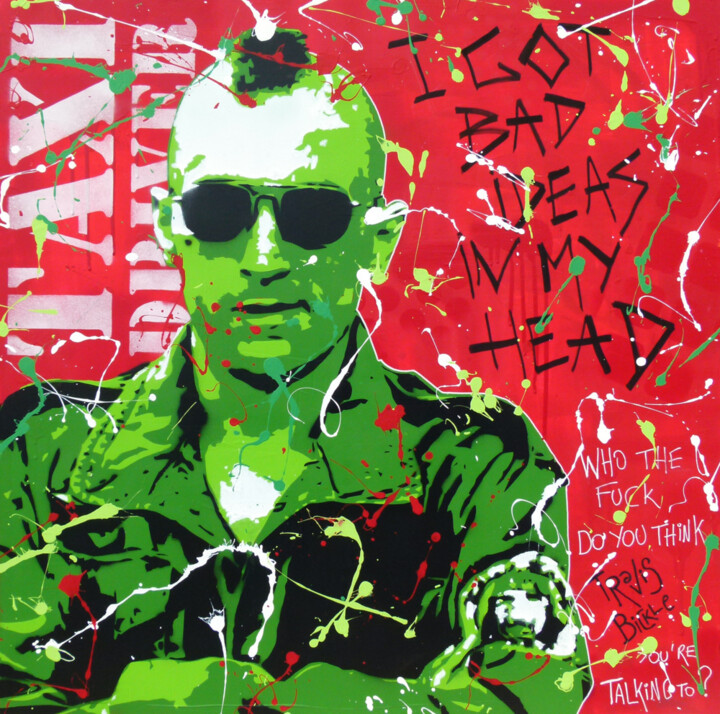 TAXI DRIVER ! (2018) Painting by Secam.
TAXI DRIVER ! (2018) Painting by Secam.
6. Taxi Driver
Robert de Niro's close-up, quotations of the film's phrases, and the film's title appear in unison on Secam's canvas, turning it into a clear celebration of one of the best-known films. My assumptions are supported by the artist's own statements in Artmajeur, which about his work states, "tribute to Robert de Niro in Taxi driver." Why must Secam have been so attracted to this film? What hidden meanings does it conceal, but actually send, to the viewer? Martin Scorsese's film, dated 1976, tells the story of a disturbed and lonely New York taxi driver who becomes increasingly detached from reality as he descends into a world of violence, so much so that it brings the viewer closer to the themes of alienation, loneliness and mental illness, interpreted by some as a silent commentary on the social and political issues of the time, including urban decay, corruption and the Vietnam War. Speaking of art history, on the other hand, alienation and mental illness are certainly part of the artistic investigation of Théodore Géricault, whose so-called Cycle of the Alienated, dating from 1822-23, brings to the canvas a deviant inner reality, aimed at demonstrating how madness was in effect an illness whose sufferers bore the marks on their faces.
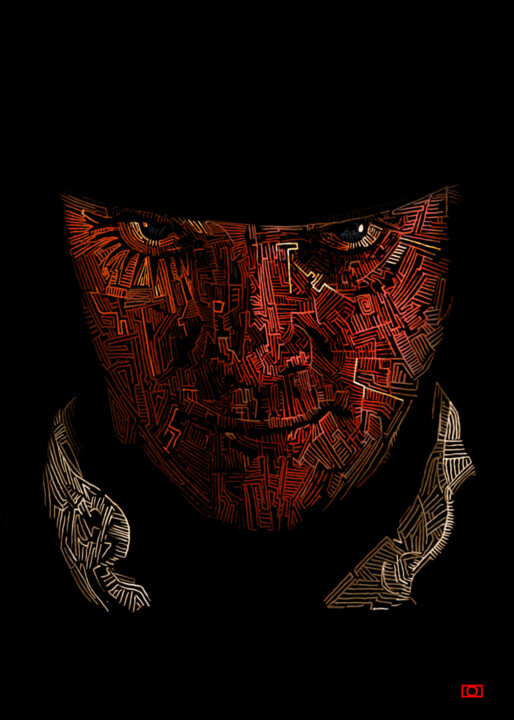 ALEX (2016) Digital Arts by Clément Delerot.
ALEX (2016) Digital Arts by Clément Delerot.
5. A Clockwork Orange
Clément Delerot's eccentric and antisocial Alex DeLarge turns his most iconic disturbed gaze on us, assuming his own likeness through the repetition of small "labyrinths" of lines, which, from the "mechanical" colors of digital art, multiply disproportionately on his person, building his features with complexity and ingenious repetition. The subject in question is the protagonist of A Clockwork Orange, Stanley Kubrick's film released in 1971, which, based on Anthony Burgess' novel of the same name, explores themes of free will, violence and the consequences of societal control. One of the very scenes in which these themes culminate is the rape scene, within which Alex and his gang assault and rape a woman while singing and dancing to classical music. In this context, the allusion to the moral decay and violence of society touches the most absolute heights, which is repeated, in a similar but decidedly softer way, in some works of art that deal with the same theme, including, for example, Giambologna's The Rape of the Sabine Women (1580-83), a sculpture from the Loggia dei Lanzi (Florence), aimed at immortalizing an episode from ancient Roman history, known as the Rape of the Sabine Women, according to which Romulus, king and founder of the city, had the Sabine women kidnapped so that the Romans would have someone to procreate with.
 DOLCE VITA (2020) Photography by Anna Sowinska.
DOLCE VITA (2020) Photography by Anna Sowinska.
4. La dolce vita
"Marcello come here". these iconic words, uttered by a rather exciting modern version of Anita Ekberg, resonate in our heads as we look at Anna Sowinska's cinematography, which repurposes, even in its title, a clear allusion to Fellini's La dolce vita, a 1960 film famous mainly for the charm of its two protagonists, rather than for its deeper meanings, which, according to critics, would reproduce a satirical and cynical portrait of the decadence and moral decay of postwar Italian society, particularly in Rome. This loss of values is enacted within surreal and dreamlike sequences that are also capable of exploring themes of alienation and existential crisis, becoming a warning against superficiality, to be replaced by something more meaningful. If this discourse sounds somewhat topical to you, more distant, on the other hand, is perhaps the lightheartedness, perhaps only superficial, of Italian Pop art at the time, well exemplified by the work of Mimmo Rotella, who in his well-known dècollages of well-known personalities, also reinterpreted the eternal charm of Mastroianni and Anita Ekberg.
 FIGHT CLUB (2023) Painting by Salomé Perignon.
FIGHT CLUB (2023) Painting by Salomé Perignon.
3. Fight club
"All the passers-by were looking at him in such a strange and singular way and he felt that they were looking at him like that, staring at him, all these faces, pale in the evening light; he wanted to stare at a thought but he couldn't, he had the feeling that in his head there was nothing but emptiness... his body was shaken with trembling, sweat was wetting him." These are the words used by Edvuard Munch to describe his experiences of alienation, summed up, pictorially speaking, in works such as Evening on Karl Johan Avenue, whose black-clad characters with tremendously white faces seem to spill out into the street like ghosts in order to head toward the viewer, who would rather scurry away. But what if this crowd does not exist and is only projections of our fears and needs? This is what we experience when our perception is challenged, as in the case of Salomé Perignon's double portrait, aimed at depicting the two main characters in the film Fight club (1999), within which, often, the line between reality and imagination becomes increasingly blurred, so much so that the audience wonders whether Tyler Durden, i.e., the Brad Pitt of the situation, really exists or is just a projection of the subconscious of the narrator's self, impersonated by Edward Norton.
 PULP FICTION INSPIRED BY BANKSY, LOVE AND POPART (2022) Painting by Antoni Dragan.
PULP FICTION INSPIRED BY BANKSY, LOVE AND POPART (2022) Painting by Antoni Dragan.
2. Pulp fiction
"Ezekiel 25:17: The path of the righteous man is threatened on every side by the wickedness of the selfish and the tyranny of evil men." These are the words uttered in Pulp fiction by Jules Winnfield, a Samuel L. Jackson who, having a banana in his fist, as depicted in Antoni Dragan's work, would wring a joyous laugh rather than a tear of terror. Getting serious again for a moment, or perhaps not, we can imagine Raphael Sanzio uttering the same quote, just a moment before he picked up his brush and brought to life the Vision of Ezekiel (c. 1517-1518. ), a panel he made respecting an episode from the Book of Ezekiel, in which the Eternal Father raises his arms in benediction, supported by two angels, the eagle, the ox and the lion, symbols of the evangelists John, Luke and Mark, while Matthew appears in the guise of the elegantly dressed angel. In addition to the sky, populated by angelic heads, and the landscape of land and sea that can be seen in the distance, it is worth pointing out how this masterpiece, presumably from the master's Roman period, was executed at a time when he used to entrust some important commissions to his most talented collaborators, so much so that some scholars have, at times, questioned Raphaelesque attribution itself.
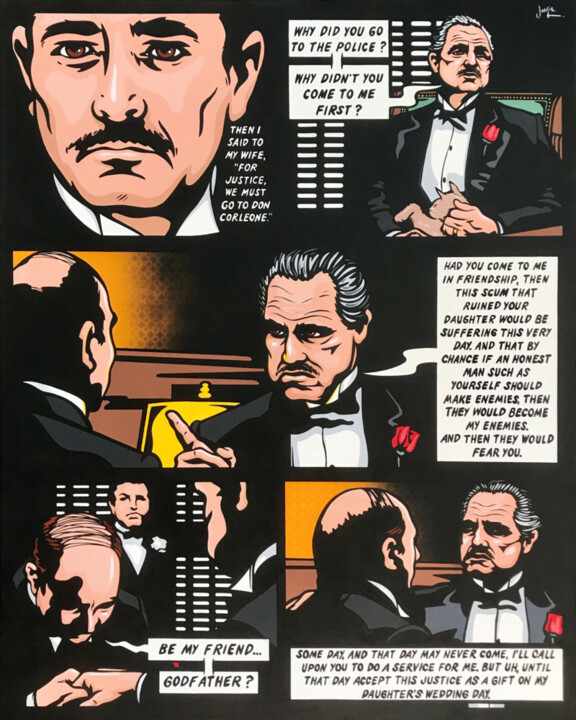 THE GODFATHER - BONASERA (2022) Painting by Jamie Lee.
THE GODFATHER - BONASERA (2022) Painting by Jamie Lee.
1.The Godfather
And the winner is: The Godfather! Leaving aside my Italian origins, Jamie Lee's Pop work reproduces, in the format and stylistic peculiarities of the comic strip, the iconic opening scene of The Godfather, in which Marlon brando, in the film Don Corleone, receives Amerigo Bonasera in his "office," making clear some basic concepts of the Mafia mentality: respect, honor, loyalty, and the silent exchange of favors. In addition, the film also explores themes of power, family, loyalty, violence and corruption, providing a nuanced portrait of the Italian-American experience in the mid-20th century United States. At this point, the art history narrative intervenes, aimed at telling of the shaky balance that exists between power and compromise, just as in the case of Gaspare Mutolo, first a Mafioso and later a collaborator with the law, who also became a painter. The so-called "Picasso of the Mafia" began to approach art in prison, a place from which his figurative passion was expressed to tell, through even blatant references, the story of Italian mala vita, approached with an approach of denunciation mixed with a probable desire for expiation. In this context, the Mafia phenomenon is narrated through symbols, so much so that criminal associations often take on the appearance of insidious octopuses, whose tentacles refer to the links and affiliates of the world's most notorious criminal organization.

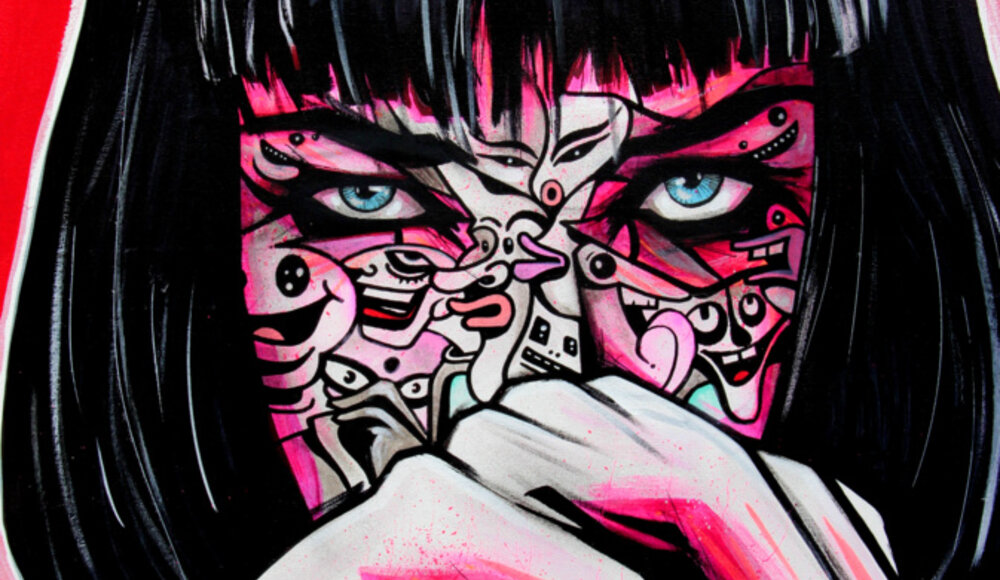
 Olimpia Gaia Martinelli
Olimpia Gaia Martinelli




